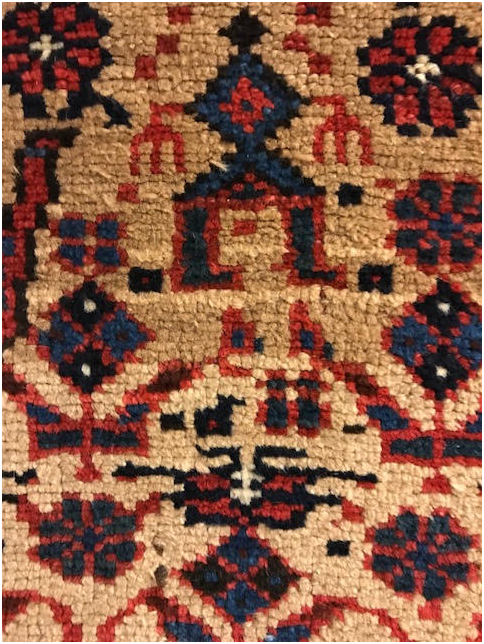
One tends to think of the oriental rug as a “Persian Rug”, but what does that mean in reference to the land of Iran or Persia? It is an ancient nation of towns and tribes, villages and cities. And rugs can be woven anywhere and most likely have been for centuries, if not millennia. There are two more or less distinct type of Persian rugs, town and country, urban and rustic. The city rugs are woven in a chain of towns reaching diagonally across Persia from Tabriz in the very northwest to Kerman in the far southeast. Tribal, nomadic and village rugs are produced around the periphery of the country.
History of Persian Rugs
In the very northwest we find the carpets of the Heriz district with large scale, semi-geometric patterns and saturated colors. These are woven near to the Caucasus, and share their bold designs and uncluttered look. Heriz carpets are some of the room size geometric pattern carpets readily available. Immediately to the east are the Shahsavan tribes, best known for their flat woven soumak technique saddlebags featuring medallions, birds and abstract elements. The Turkmen Yomud and Tekke tribes of northeast Persia weave rugs closely resembling their confreres in Turkmenistan, with red fields and allover repeating gul medallion patterns. They also create numerous smaller rugs domestic paraphernalia, all eminently collectible. Along the very northeast border are the Quchan Kurds, transported centuries ago from Kurdistan in the west, who weave geometric rugs in bright colors influenced by Turkmen, Baluch and Turkish archetypes, but truly their own in style.
Antique Persian Carpet Variations
Along the eastern edge of Persia are the nomadic Baluch tribes with a bewildering variety of small rugs in camel, deep reds and blues with very soft wool. Prayer rugs are a speciality with many Baluch tribes. All the tribes skirt the great interior deserts of the land. In the far southeast near to Kerman are the Afshars and related groups. They weave anything: adapted city patterns, textile designs, medallions, borrowings from other tribal groups, with an equally wide variety of structures. All are colorful and idiosyncratic. More tribal folk, some of whom are considered the best nomadic weavers in Iran are located around the southern city of Shiraz. The Qashqai weave fully decorated, finely knotted rugs with semi-geometric patterns, including flowers, on flat looms in mostly scatter sizes. They love botehs, stripes, diamond medallions, and hooks as color transitions are everywhere. Their neighbors, the Khamseh tribal group, follow the same aesthetic, but add whimsical birds and animals to well filled fields in dark blue or red. Their general weaving quality is slightly lower than that of the Qashqai, but the rugs are often confused in the market. The Luri tribes range to the west and their patterns are tribal, but with small, scale floral elements predominating.
Bakhtiari rugs are both village and nomad productions. They originate in an area to the southwest of Isfahan. Strong colors, including a vibrant yellow, and allover lattice and title panel patterns are among the most popular designs. Room size carpets are frequent, but so are tribal bags mixing various techniques.
In the very western province of Kurdistan, the various Kurdish tribes, villages and towns weave a broad selection of rugs carpets, rugs and bags. The town of Senneh is known for small pieces of exceptional finesse in a totally urban manner, in both allover and medallion patterns, while the town of Bidjar and surrounding villages make the most durable of all oriental carpets. Again, colors are crisp, and dark blue, warm red and a golden yellow are favored in both allover and medallion patterns. Other towns include Sauj Bulagh with large size carpets in classic Persian repeating patterns. The lesser villagers and local migratory tribes weave an exceptional variety of semi-geometric rugs, on wool foundations, with wonky repeating patterns. The best known of the domestic wares are the Jaff Kurd saddlebags with allover multicolor diamond patterns, More Kurds reside around the ancient city of Hamadan and they weave rugs in floating medallion, lattice, “lightning bolt”, pole medallion or tile pattern designs, among hundreds of others. Camel is particularly popular as a ground tone.
This is only the briefest survey of Persian village rugs creativity and books could be, and have been written on many of the groups quickly touched on above. Each tribe or locale has produced artistically meritorious rugs and these are available to anyone wanting to put a bit of exotic and authentic culture on the floor.

I don’t think the title of your article matches the content lol. Just kidding, mainly because I had some doubts after reading the article.
Yo! 711php is calling my name. I’m diving in. Wish me luck! Anyone had any big wins here? Let’s get it! Peep this out 711php!
Your point of view caught my eye and was very interesting. Thanks. I have a question for you. https://accounts.binance.info/ar/register-person?ref=53551167
Your point of view caught my eye and was very interesting. Thanks. I have a question for you.